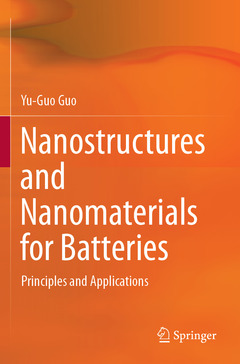Nanostructures and Nanomaterials for Batteries, 1st ed. 2019 Principles and Applications

This book discusses the roles of nanostructures and nanomaterials in the development of battery materials for state-of-the-art electrochemical energy storage systems, and provides detailed insights into the fundamentals of why batteries need nanostructures and nanomaterials. It explores the advantages offered by nanostructure electrode materials, the challenges of using nanostructured materials in batteries, as well as the rational design of nanostructures and nanomaterials to achieve optimal battery performance. Further, it closely examines the latest advances in the application of nanostructures and nanomaterials for future rechargeable batteries, including high-energy and high-power lithium ion batteries, lithium metal batteries (Li-O2, Li-S, Li-Se, etc.), all-solid-state batteries, and other metal batteries (Na, Mg, Al, etc.). It is a valuable reference resource for readers interested in or involved in research on energy storage, energy materials, electrochemistry and nanotechnology.
General introduction to electrochemical energy storage.- Fundamentals of nanostructures and nanomaterials for batteries.- Nanostructures and nanomaterials for lithium-ion batteries.- Nanostructures and nanomaterials for lithium metal batteries (Li-O2, Li-S, Li-Se, etc.).- Nanostructures and nanomaterials for all-solid-state batteries.- Nanostructures and nanomaterials for other metal batteries (Na, Mg, Al, etc.).- Traditional nanostructures for batteries.-Conclusions and perspectives.
Prof. Yu-Guo Guo received his Ph.D. in Physical Chemistry from ICCAS in 2004. He worked at the Max Planck Institute for Solid State Research in Stuttgart (Germany), first as a Guest Scientist and then a Staff Scientist. He joined ICCAS as a Full Professor in 2007. He has served as an Associate Editor of ACS Applied Materials and Interfaces since 2015. His research focuses on electrochemical energy storage using batteries, including Li-S, Li-Se, Na-S, Na-ion and Mg-ion batteries. He has published more than 200 papers in peer-reviewed journals. He has filed 16 PCT patents and 81 patents in China in the field of energy materials and batteries. He has received several awards including the International Coalition for Energy Storage & Innovation Young Career Award (2018), the International Academy of Electrochemical Energy Science (IAOEES) Excellent Research Award (2016), the International Society of Electrochemistry Tajima Prize (2014), the 13th National Award for Youthin Science and Technology (2013), the IUPAC Prof. Jiang Novel Materials Youth Prize (2013) and the MIT Technology Review’s TR35 Award (2011). He has been named as a “Thomson Reuters Highly Cited Researcher” in the field of Materials Science five times (from 2014 to 2018).
Date de parution : 08-2020
Ouvrage de 379 p.
15.5x23.5 cm
Date de parution : 06-2019
Ouvrage de 379 p.
15.5x23.5 cm



